
Unit 4: NIMS Communications and
Information Management
This page intentionally left blank.

IS-0700.A: National Incident Management System, An Introduction
Objectives
At the end of this unit, you should be able to:
Describe the importance of communications and information management.
Define the concepts of common operating picture and interoperability.
Describe the purpose of communications and information management standards,
procedures, and protocols.
Scope
Unit Introduction and Objectives
Video: What is NIMS Communications and Information Management?
Characteristics of Effective Communications Systems
Flexible Communications and Information Systems
Common Operating Picture
Interoperability
Reliability, Portability, Scalability
Resiliency and Redundancy
Activity
Standards, Procedures, and Protocols
Standardized Communications Types
Policy and Planning
Agreements
Equipment Standards and Training
Incident Information
Communications and Data Standards
Plain Language & Common Terminology
Knowledge Review and Summary
Preparedness Self-Assessment
October 2014 Student Manual Page 4-i

IS-0700.A: National Incident Management System, An Introduction
This page intentionally left blank.
Page 4-ii Student Manual October 2014

IS-0700.A: National Incident Management System, An Introduction
Key Points
This unit presents an overview of the NIMS Communications and Information Management
component.
October 2014 Student Manual Page 4-1
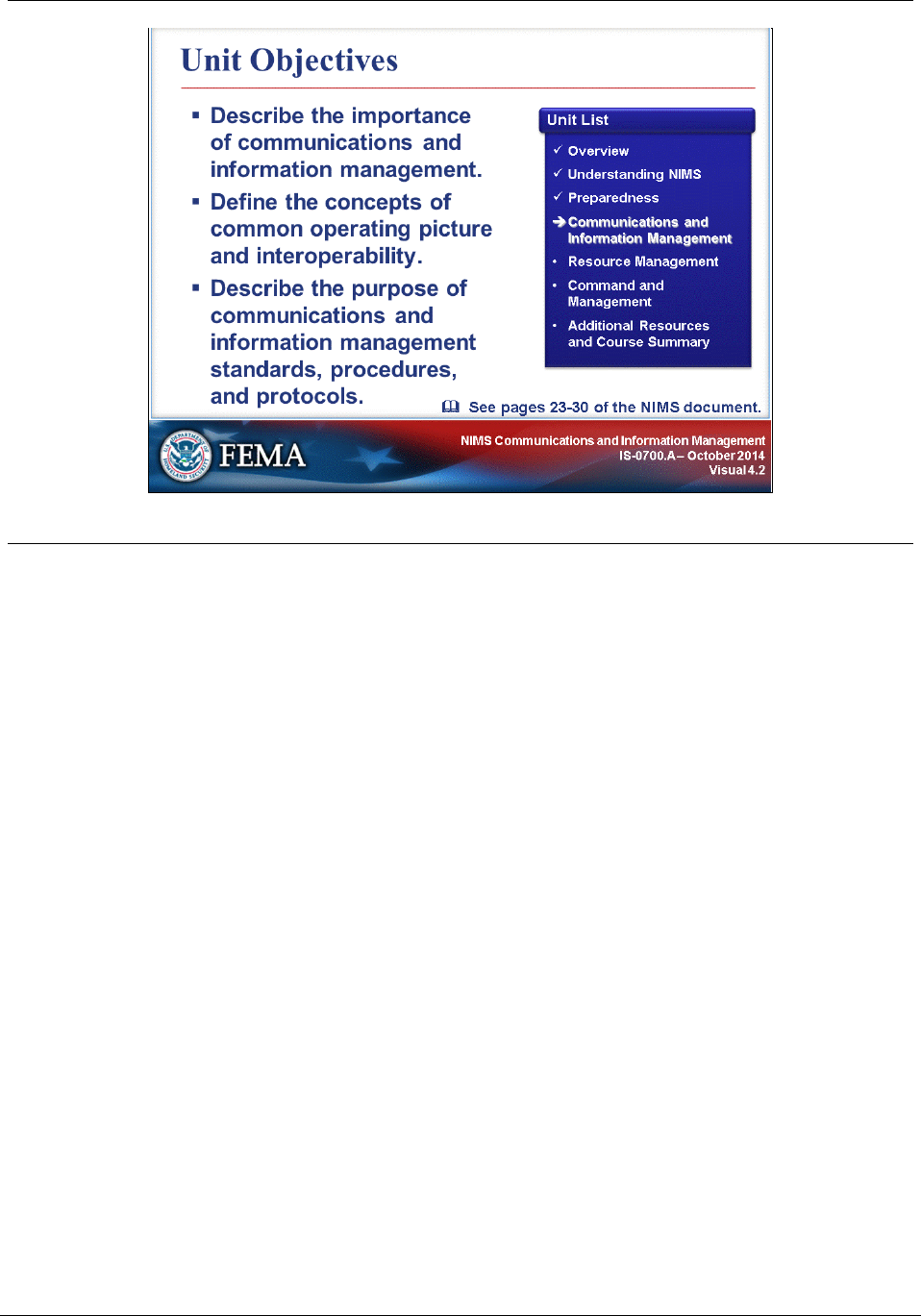
IS-0700.A: National Incident Management System, An Introduction
Key Points
At the end of this unit, you should be able to:
Describe the importance of communications and information management.
Define the concepts of common operating picture and interoperability.
Describe the purpose of communications and information management standards,
procedures, and protocols.
This unit summarizes the information presented in Component II: Communications and
Information Management, including:
Concepts and Principles
Management Characteristics
Organization and Operations
Refer to pages 23 through 30 of the NIMS document.
Page 4-2 Student Manual October 2014
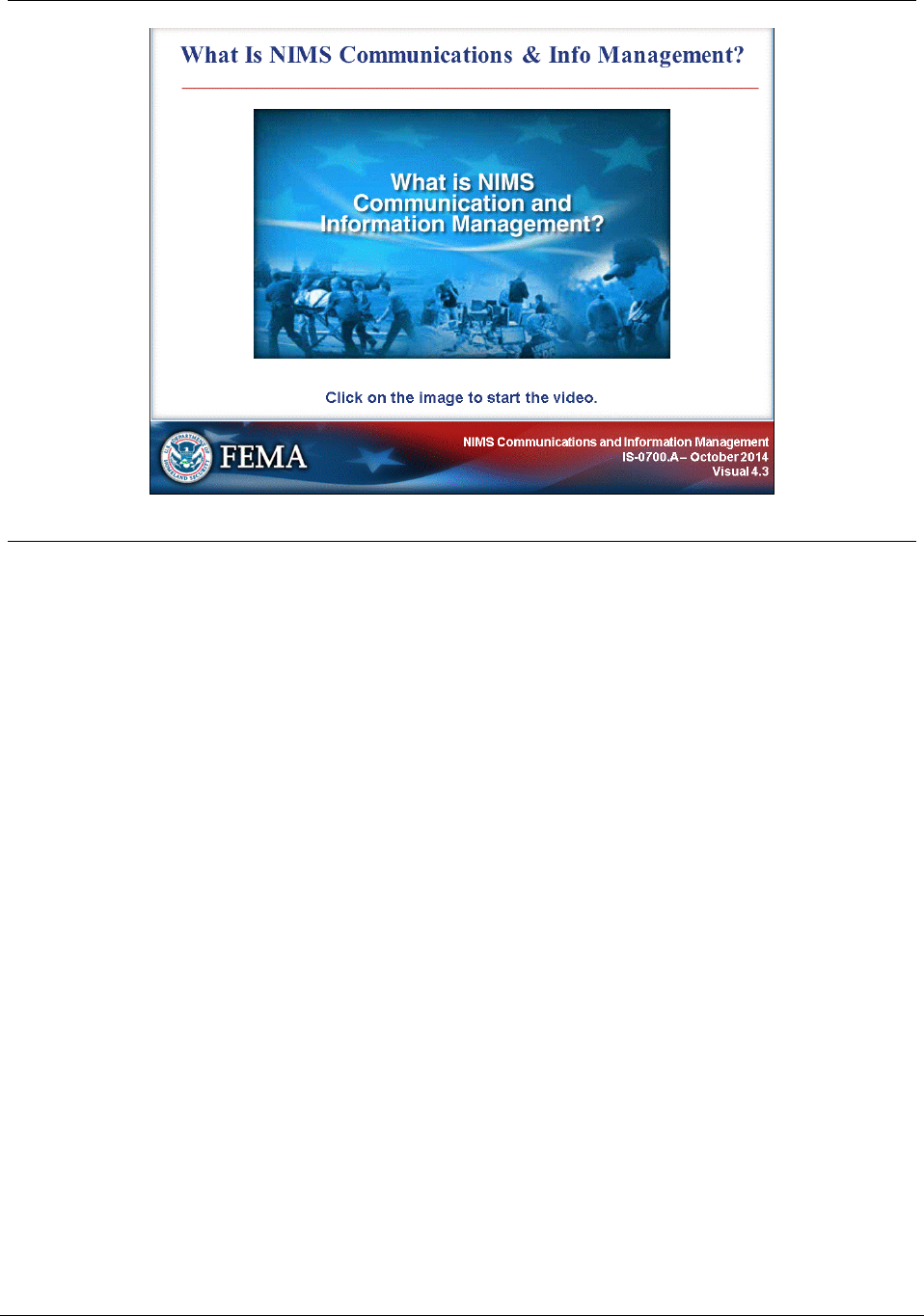
IS-0700.A: National Incident Management System, An Introduction
Key Points
This video provides an introduction to the NIMS Communications and Information Management
component.
Video Transcript: Effective emergency response depends on communication—the ability to
maintain a common operating picture through the constant flow of information.
During and after Hurricane Katrina, communications systems failed, severely hampering
information flow and response operations. In New Orleans, most of the city was flooded. The
combined effects of wind, rain, storm surge, breached levees, and flooding knocked out virtually
the entire infrastructure—electrical power, roads, water supply and sewage, and
communications systems.
Thomas Stone, Fire Chief, St. Bernard Parish: “We lost our communications system, and when
you are not able to communicate, you can’t coordinate your response. You never think that you
will lose your entire infrastructure.”
Communications problems are not limited to systems being destroyed or not functioning. Similar
problems arise when agencies cannot exchange needed information because of incompatible
systems. NIMS identifies several important features of public safety communications and
information systems.
Communications systems need to be:
Interoperable—able to communicate within and across agencies and jurisdictions.
Reliable—able to function in the context of any kind of emergency.
Portable—built on standardized radio technologies, protocols, and frequencies.
Scalable—suitable for use on a small or large scale as the needs of the incident dictate.
October 2014 Student Manual Page 4-3

IS-0700.A: National Incident Management System, An Introduction
Resilient—able to perform despite damaged or lost infrastructure.
Redundant—able to use alternate communications methods when primary systems go out.
Regardless of the communications hardware being used, standardized procedures, protocols,
and formats are necessary to gather, collate, synthesize, and disseminate incident information.
And in a crisis, life-and-death decisions depend on the information we receive.
This lesson introduces you to the NIMS Communications and Information Management
component.
Page 4-4 Student Manual October 2014
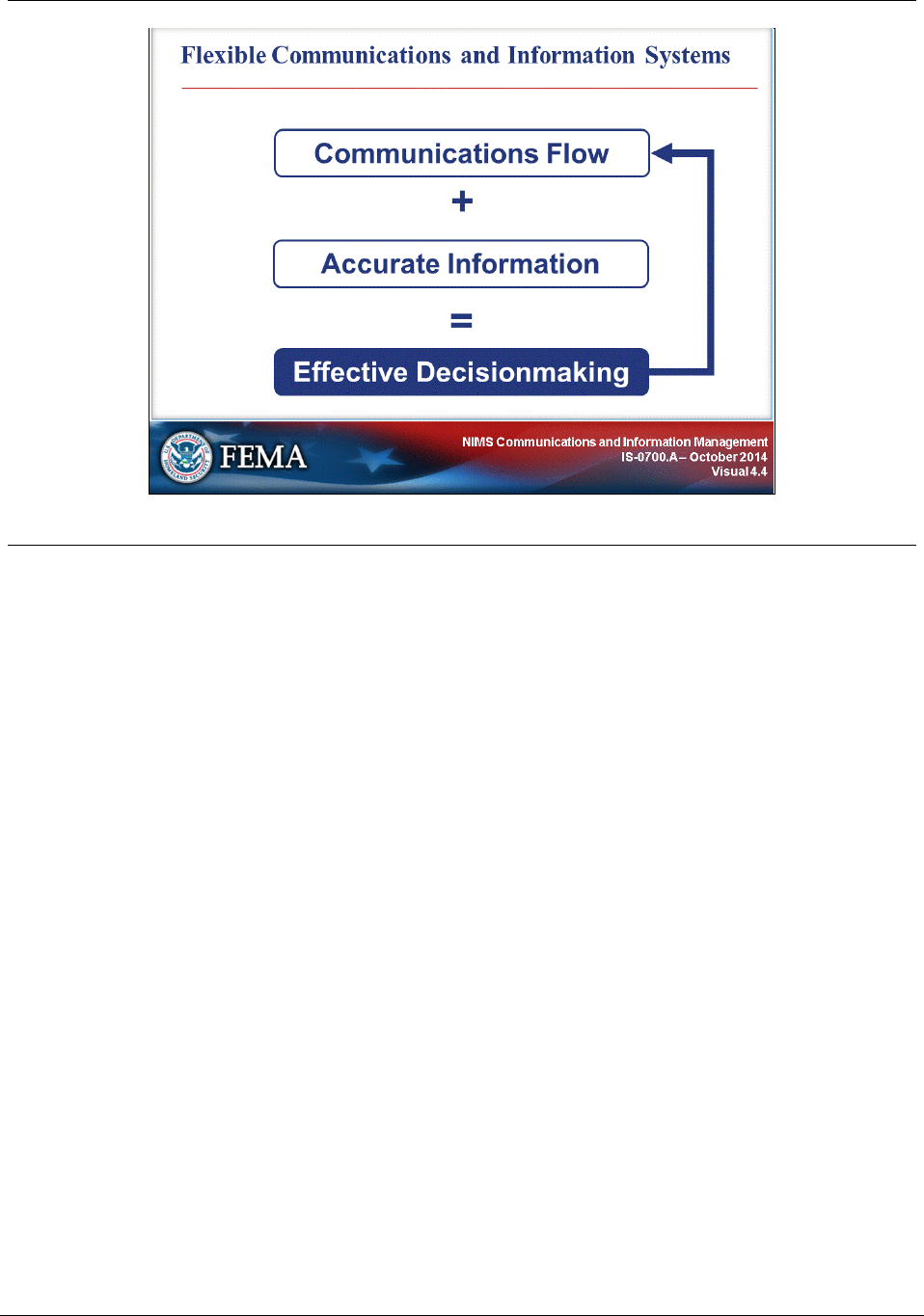
IS-0700.A: National Incident Management System, An Introduction
Key Points
All too often, after-action reports cite communications failures as an impediment to effective
incident management.
Communications breakdowns are not limited to equipment and systems-related failures. The
use of different protocols, codes instead of plain language, and nonstandardized reporting
formats hampers our ability to share critical information and make effective decisions.
To overcome these past problems, the NIMS Communications and Information Management
component promotes the use of flexible communications and information systems.
October 2014 Student Manual Page 4-5
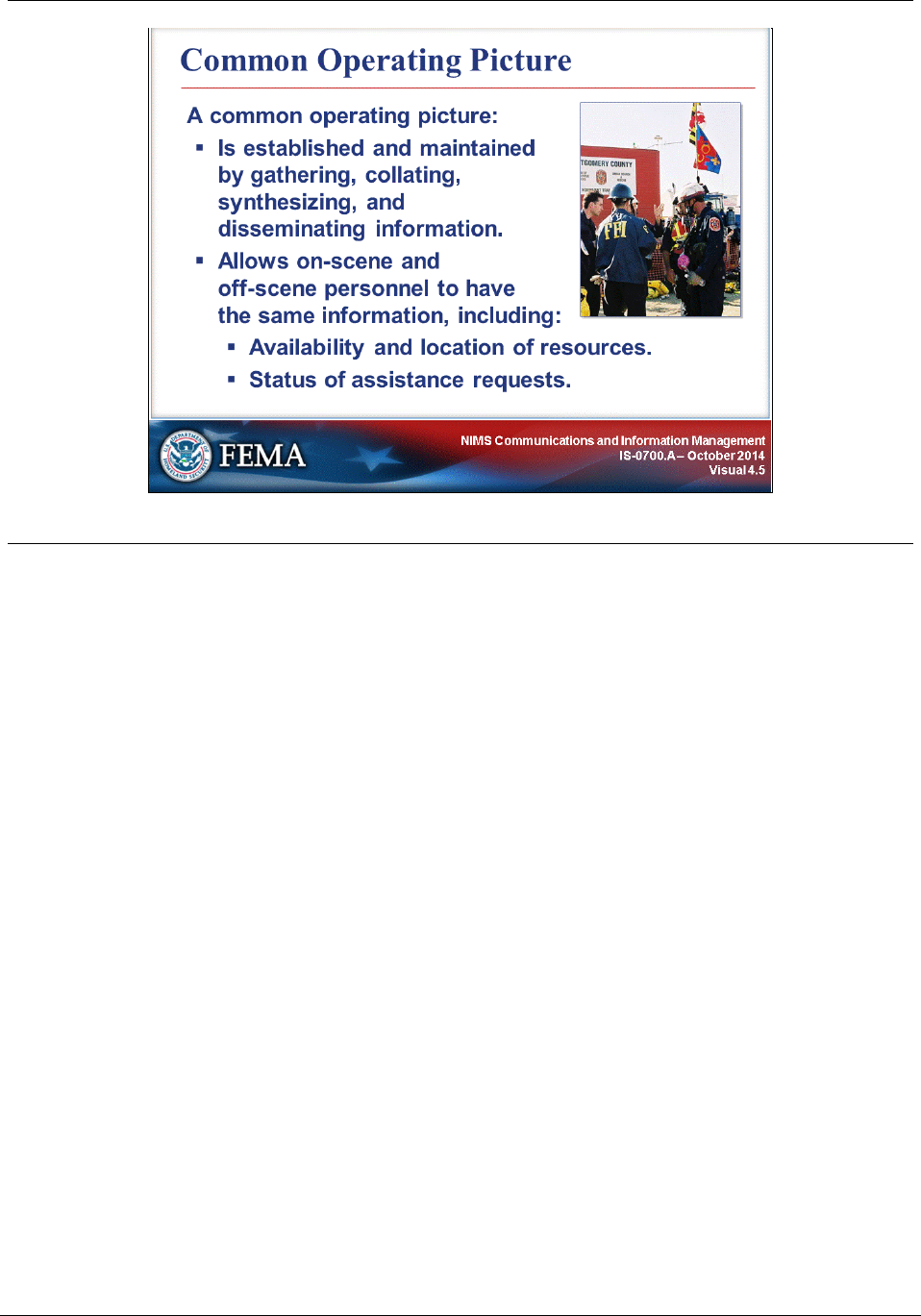
IS-0700.A: National Incident Management System, An Introduction
Key Points
A common operating picture is established and maintained by gathering, collating, synthesizing,
and disseminating incident information to all appropriate parties.
Achieving a common operating picture allows on-scene and off-scene personnel—such as
those at the Incident Command Post, Emergency Operations Center, or within a Multiagency
Coordination Group—to have the same information about the incident, including the availability
and location of resources and the status of assistance requests.
Page 4-6 Student Manual October 2014
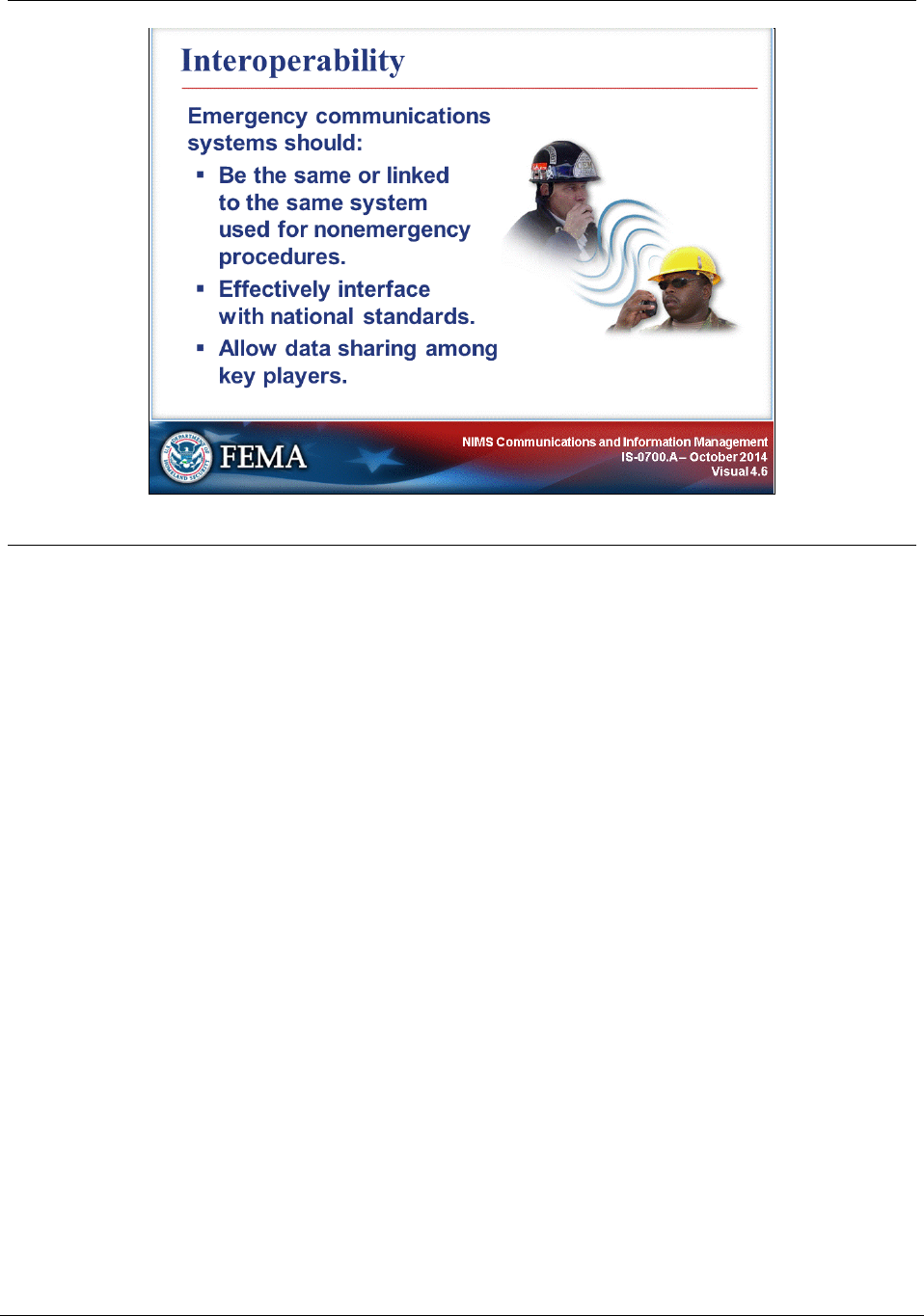
IS-0700.A: National Incident Management System, An Introduction
Key Points
First and foremost, interoperability is the ability of emergency management/response
personnel to interact and work well together.
Interoperability also means that technical emergency communications systems should:
Be the same or linked to the same system that the jurisdiction uses for nonemergency
procedures.
Effectively interface with national standards, as they are developed.
Allow the sharing of data throughout the incident management process and among all key
players.
October 2014 Student Manual Page 4-7

IS-0700.A: National Incident Management System, An Introduction
Key Points
The following examples to explain the value of interoperability:
Jan. 13, 1982: Air Florida Flight 90 crashed into the 14th St. Bridge in Washington, DC, during a
snowstorm. More than 70 people lost their lives. Police, fire, and EMS crews responded quickly
to the scene but experienced coordination problems because they could not communicate with
one another.
Sept. 11, 2001: When American Airlines Flight 77 crashed into the Pentagon, 900 responders
from 50 different agencies were able to communicate with one another. Response agencies had
learned an invaluable lesson from the Air Florida tragedy. Regional coordination within the
Washington area led to the adoption of the Incident Command System, establishment of
interoperable communications protocols, and execution of mutual aid plans. The next challenge
to solve was the lack of direct interoperability with secondary response agencies.
Page 4-8 Student Manual October 2014

IS-0700.A: National Incident Management System, An Introduction
Key Points
To achieve interoperability, communications and information systems should be designed to be:
Reliable—able to function in any type of incident, regardless of cause, size, location, or
complexity.
Portable—built on standardized radio technologies, protocols, and frequencies that allow
communications systems to be deployed to different locations and integrated seamlessly
with other systems.
Scalable—suitable for use on a small or large scale, allowing for an increasing number of
users.
October 2014 Student Manual Page 4-9

IS-0700.A: National Incident Management System, An Introduction
Key Points
Communications systems ensure that the flow of information will not be interrupted during an
incident through:
Resiliency—able to withstand and continue to perform after damage or loss of
infrastructure.
Redundancy—providing for either duplication of identical services or the ability to
communicate through diverse, alternative methods when standard capabilities suffer
damage.
Page 4-10 Student Manual October 2014
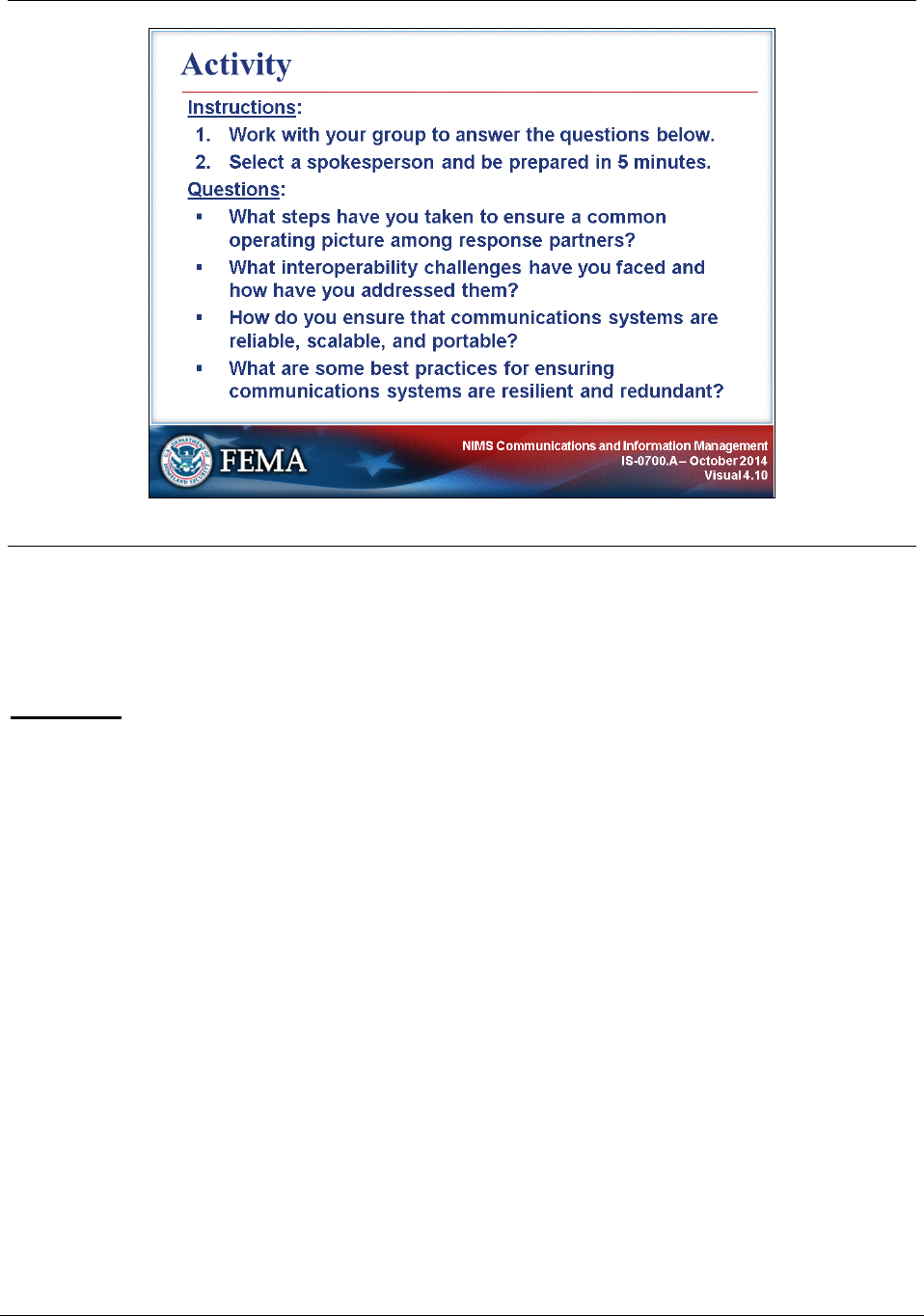
IS-0700.A: National Incident Management System, An Introduction
Key Points
Instructions:
1. Work with your group to answer the questions below.
2. Select a spokesperson and be prepared in 5 minutes.
Questions:
What steps have you taken to ensure a common operating picture among response
partners?
What interoperability challenges have you faced and how have you addressed them?
How do you ensure that communications systems are reliable, scalable, and
portable?
What are some best practices for ensuring communications systems are resilient and
redundant?
October 2014 Student Manual Page 4-11
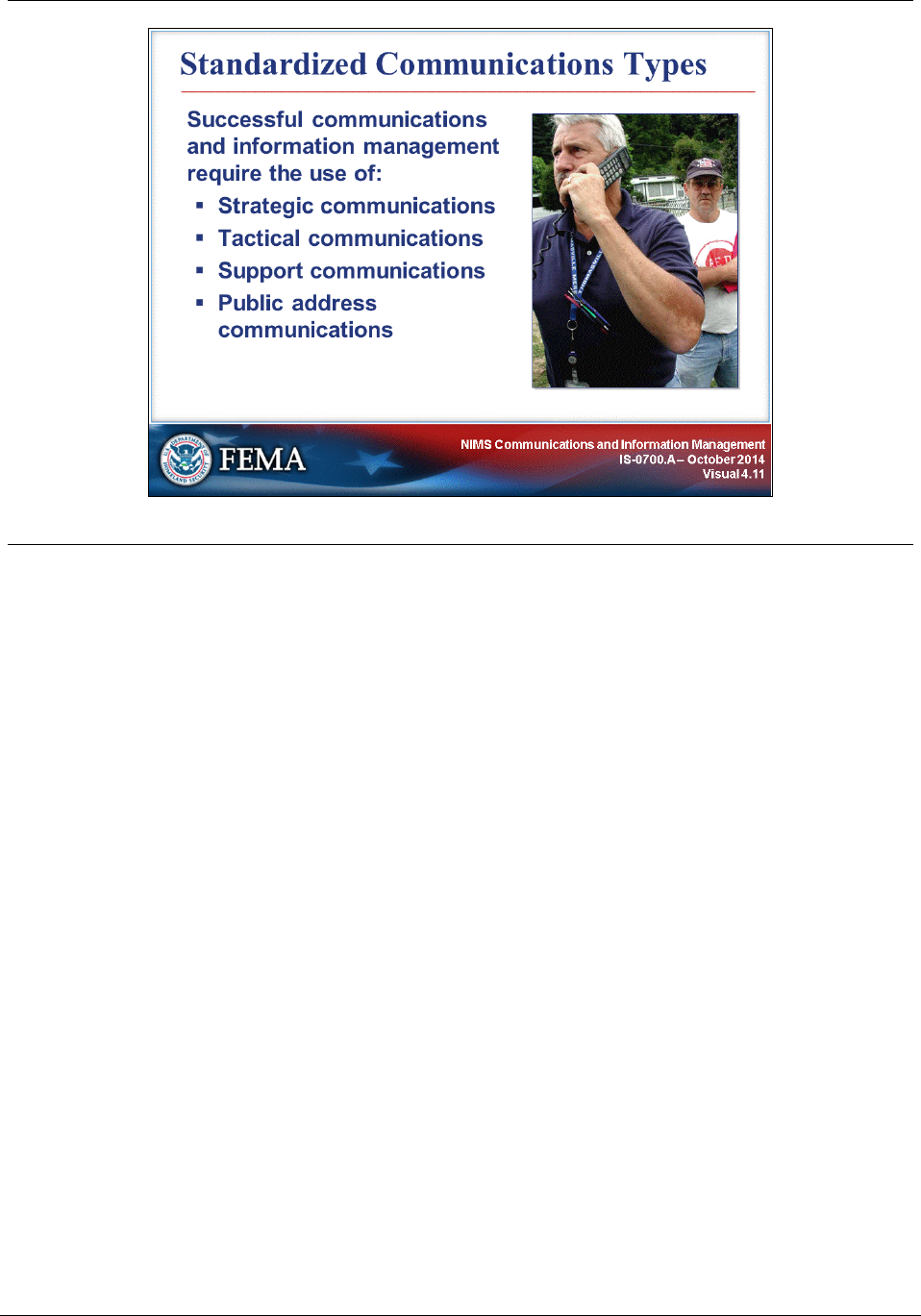
IS-0700.A: National Incident Management System, An Introduction
Key Points
Successful communications and information management require that emergency
management/response personnel and their affiliated organizations use the following types of
standardized communications:
Strategic Communications: High-level directions, including resource priority decisions,
roles and responsibilities determinations, and overall incident response courses of action.
Tactical Communications: Communications between command and support elements
and, as appropriate, cooperating agencies and organizations.
Support Communications: Coordination in support of strategic and tactical
communications (for example, communications among hospitals concerning resource
ordering, dispatching, and tracking from logistics centers; traffic and public works
communications).
Public Address Communications: Emergency alerts and warnings, press conferences,
etc.
The determination of the individual or agency/organization responsible for these
communications is discussed in the NIMS Command and Management unit.
Page 4-12 Student Manual October 2014

IS-0700.A: National Incident Management System, An Introduction
Key Points
Coordinated communications policy and planning provide the basis for effective
communications and information management.
All relevant stakeholders should be involved in planning sessions in order to formulate
integrated communications plans and strategies. Technology and equipment standards also
should be shared when appropriate, to provide stakeholders with the opportunity to be
interoperable and compatible.
Sound communications management policies and plans should include information about the
following aspects of communications and information management:
Information needs should be defined by the jurisdiction/organization. These needs are often
met at the Federal, State, tribal, and local levels, in concert with NGOs and the private
sector, and primarily through preparedness organizations.
The jurisdiction’s or organization’s information management system should provide
guidance, standards, and tools to enable the integration of information needs into a common
operating picture when needed.
Procedures and protocols for the release of warnings, incident notifications, public
communications, and other critical information are disseminated through a defined
combination of networks used by the Emergency Operations Center. Notifications are made
to the appropriate jurisdictional levels and to NGOs and the private sector through defined
mechanisms specified in emergency operations and incident action plans.
Agencies at all levels should plan in advance for the effective and efficient use of information
management technologies (e.g., computers, networks, and information-sharing
mechanisms) to integrate all command, coordination, and support functions involved in
incident management and to enable the sharing of critical information and the cataloging of
required corrective actions.
October 2014 Student Manual Page 4-13
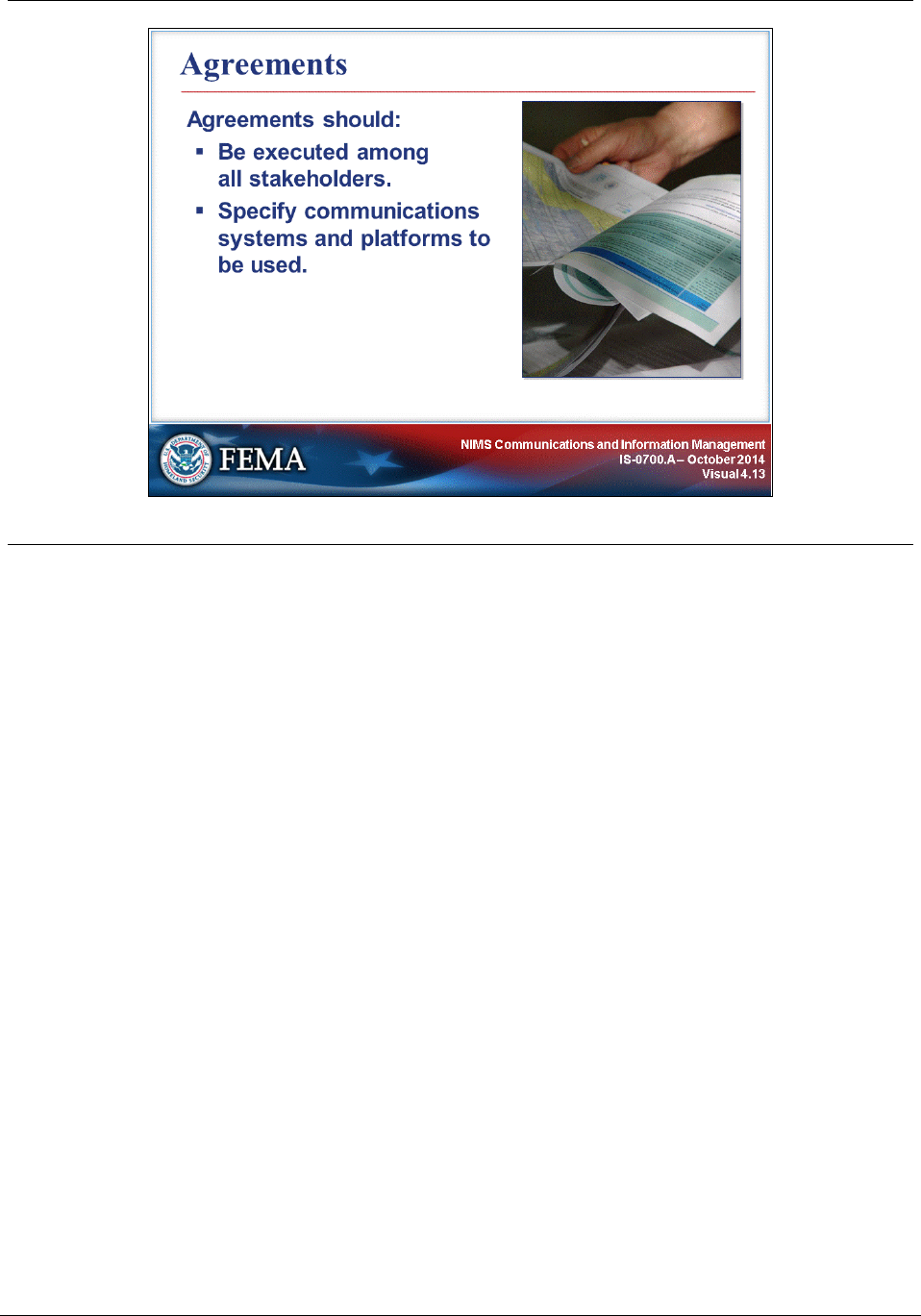
IS-0700.A: National Incident Management System, An Introduction
Key Points
Agreements should be executed among all stakeholders to ensure that the elements within
plans and procedures will be in effect at the time of an incident.
Agreements should specify all of the communications systems and platforms through which the
parties agree to use or share information
Page 4-14 Student Manual October 2014

IS-0700.A: National Incident Management System, An Introduction
Key Points
Standards help ensure a seamless interface between communications systems, especially
between the public and private sectors. Standards should address:
The wide range of conditions under which communications systems must operate.
The need for maintenance and updating of the systems and equipment.
The periodic testing of systems.
Periodic training and exercises are essential so that personnel capabilities and limitations of
communications plans and systems are addressed before an incident.
October 2014 Student Manual Page 4-15
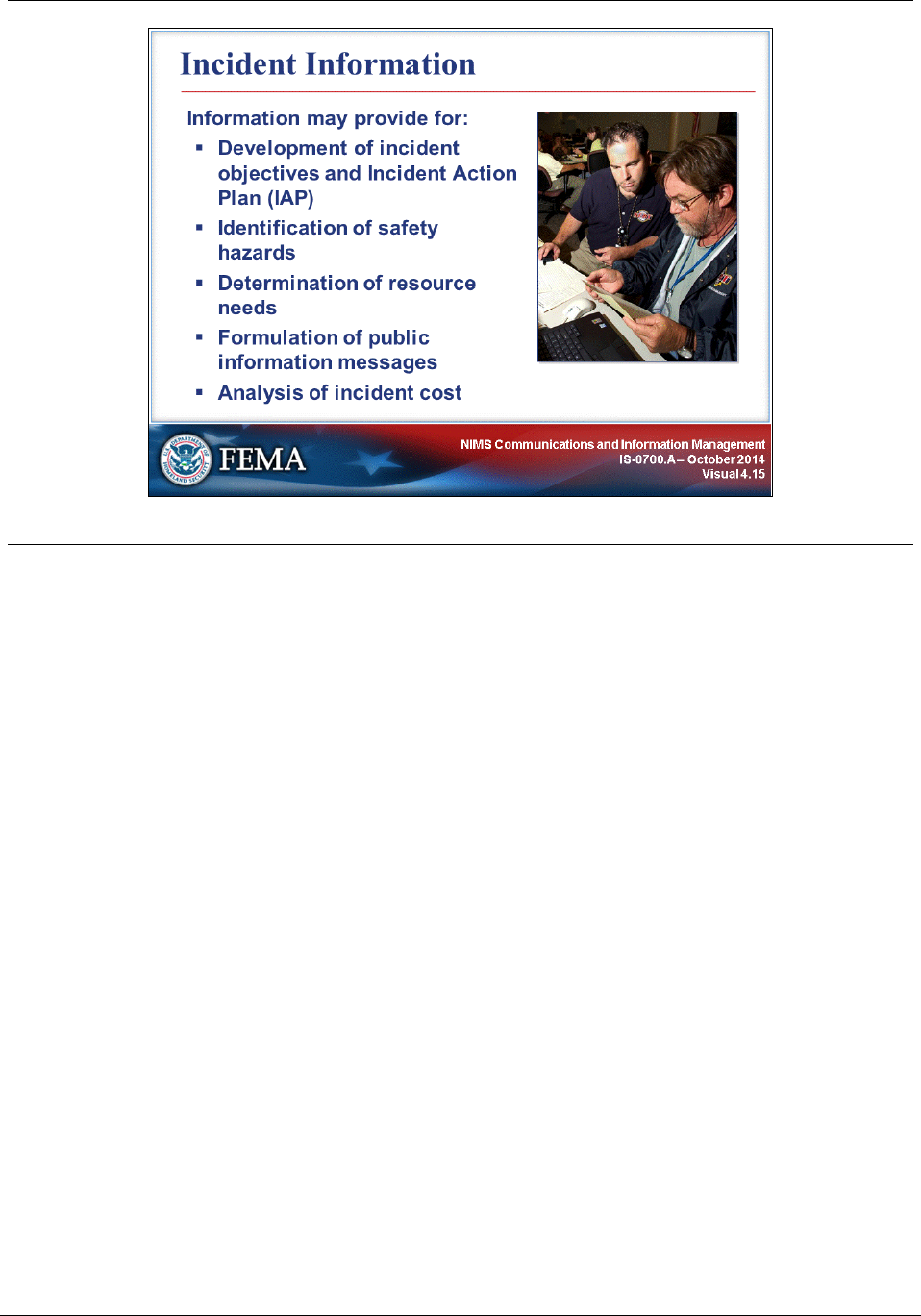
IS-0700.A: National Incident Management System, An Introduction
Key Points
Shared information is vital to the Incident Commander, Unified Command, and decisionmakers
within supporting agencies and organizations. A single piece of information may provide input
for development of incident objectives and the Incident Action Plan (IAP), identification of safety
hazards, determination of resource needs, formulation of public information messages, and
analysis of incident cost.
The following examples of information generated by an incident that can be used for
decisionmaking purposes:
Incident Notification, Situation, and Status Reports: Incident reporting and
documentation procedures should be standardized to ensure that situational awareness is
maintained and that emergency management/response personnel have easy access to
critical information. Situation reports offer a snapshot of the past operational period and
contain confirmed or verified information regarding the explicit details (who, what, when,
where, and how) relating to the incident. Status reports, which may be contained in situation
reports, relay information specifically related to the status of resources (e.g., availability or
assignment of resources).
Analytical Data: Data, such as information on public health and environmental monitoring,
should be collected in a manner that observes standard data collection techniques and
definitions. The data should then be transmitted using standardized analysis processes.
During incidents that require public health and environmental sampling, multiple
organizations at different levels of government often collect data, so standardization of data
collection and analysis is critical. Additionally, standardization of sampling and data
collection enables more reliable analysis and improves the quality of assessments provided
to decisionmakers.
Page 4-16 Student Manual October 2014

IS-0700.A: National Incident Management System, An Introduction
Geospatial Information: Geospatial information is defined as information pertaining to the
geographic location and characteristics of natural or constructed features and boundaries. It
is often used to integrate assessments, situation reports, and incident notification into a
common operating picture and as a data fusion and analysis tool to synthesize many kinds
and sources of data and imagery. The use of geospatial data (and the recognition of its
intelligence capabilities) is increasingly important during incidents. Geospatial information
capabilities (such as nationally consistent grid systems or global positioning systems based
on lines of longitude and latitude) should be managed through preparedness efforts and
integrated within the command, coordination, and support elements of an incident, including
resource management and public information.
October 2014 Student Manual Page 4-17
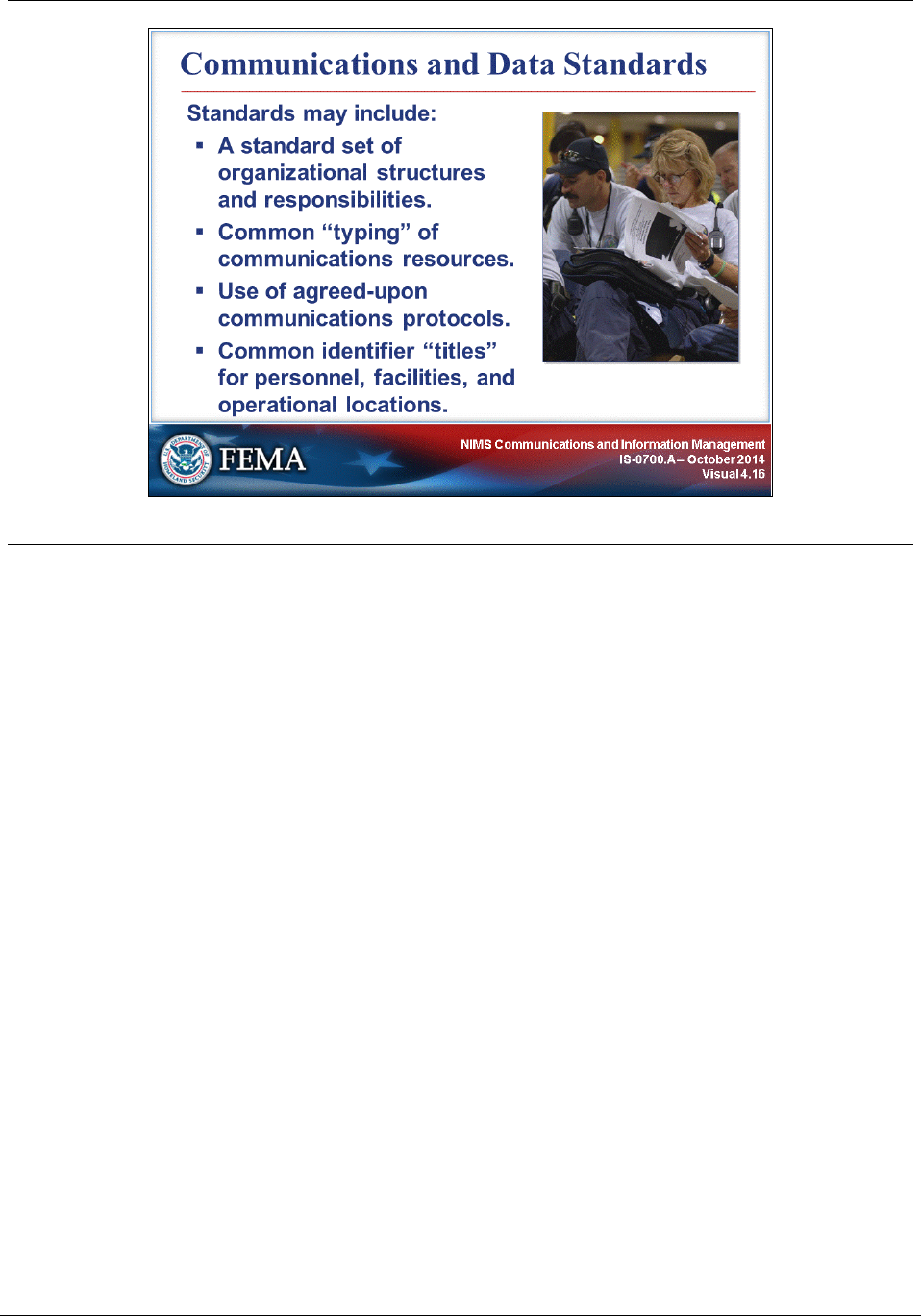
IS-0700.A: National Incident Management System, An Introduction
Key Points
Communications and data standards are established to allow diverse organizations to work
together effectively. Standards may include:
A standard set of organizational structures and responsibilities.
Common “typing” of communications resources to reflect specific capabilities.
Use of agreed-upon communications protocols.
Common identifier “titles” for personnel, facilities, and operational locations used to support
incident operations.
Page 4-18 Student Manual October 2014
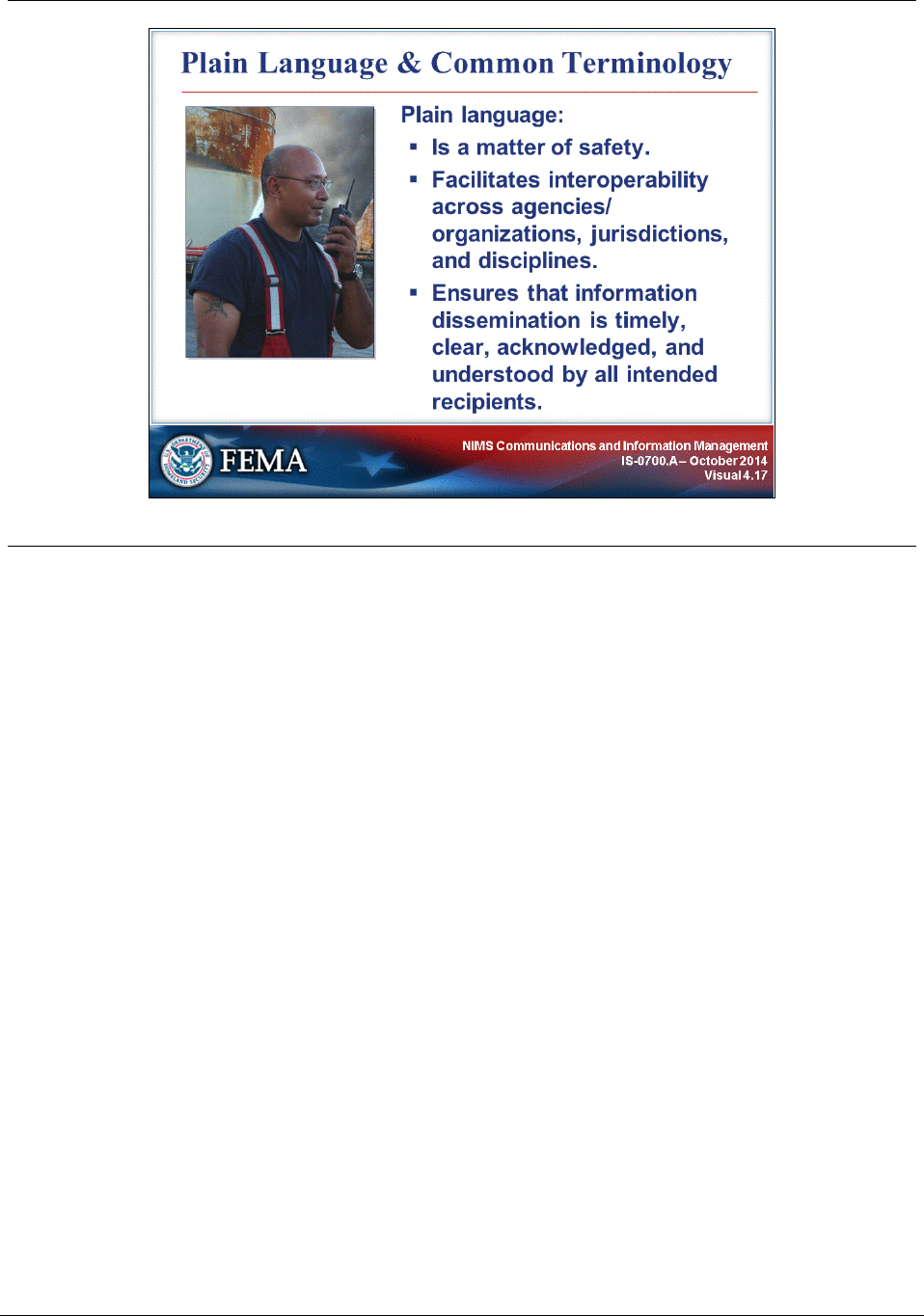
IS-0700.A: National Incident Management System, An Introduction
Key Points
The use of plain language in emergency management and incident response:
Is a matter of safety.
Facilitates interoperability across agencies/organizations, jurisdictions, and disciplines.
Ensures that information dissemination is timely, clear, acknowledged, and understood by
all intended recipients.
Codes should not be used, and all communications should be confined to essential messages.
The use of acronyms should be avoided during incidents requiring the participation of multiple
agencies or organizations.
When necessary, information may need to be encrypted so that security can be maintained.
Although plain language may be appropriate during response to most incidents, tactical
language is occasionally warranted due to the nature of the incident (e.g., during an ongoing
terrorist event).
The protocols for using specialized encryption and tactical language should be incorporated into
the Incident Action Plan or incident management communications plan
October 2014 Student Manual Page 4-19

IS-0700.A: National Incident Management System, An Introduction
Key Points
Answer the following discussion questions:
What challenges has your organization faced in incident communications? How were
they addressed?
What are the benefits of using plain language and common terminology during an
incident?
Page 4-20 Student Manual October 2014

IS-0700.A: National Incident Management System, An Introduction
Key Points
Instructions:
Answer the review questions on the next page.
Be prepared to share your answers with the class in 5 minutes.
If you need clarification on any of the material presented in this unit, ask your instructors.
October 2014 Student Manual Page 4-21

IS-0700.A: National Incident Management System, An Introduction
Unit 4: Knowledge Review
1. W
hat is “an overview of an incident by all relevant parties that provides incident information
enabling the Incident Commander/Unified Command and any supporting agencies and
organizations to make effective, consistent, and timely decisions”?
2. M
atch the term on the left by writing in the letter with the correct matching definition on the right.
Term
Description
____
Reliability
A. Communication systems have been
designed with sufficient expandable
capacity for routine responses as well as
more major incidents.
____
Portability
B. Physical protections have been installed to
secure a computer network and
communications equipment.
____
Scalability
C. Exercises are conducted to test that
systems are able to function in any type of
incident, regardless of cause, size, location,
or complexity.
____
Resiliency
D. Backup power systems have been installed
to maintain communications systems.
Alternate communications devices, such as
satellite phones, are available if standard
capabilities suffer damage.
____
Redundancy
E. All equipment acquired complies with
standardized radio technologies, protocols,
and frequencies to ensure that it will
operate at different locations and integrate
seamless with other systems.
Page 4-22 Student Manual October 2014

IS-0700.A: National Incident Management System, An Introduction
3. What is interoperability? Why is it important?
4. U
se the space below to make note of any questions you have about the material covered in
this unit.
October 2014 Student Manual Page 4-23
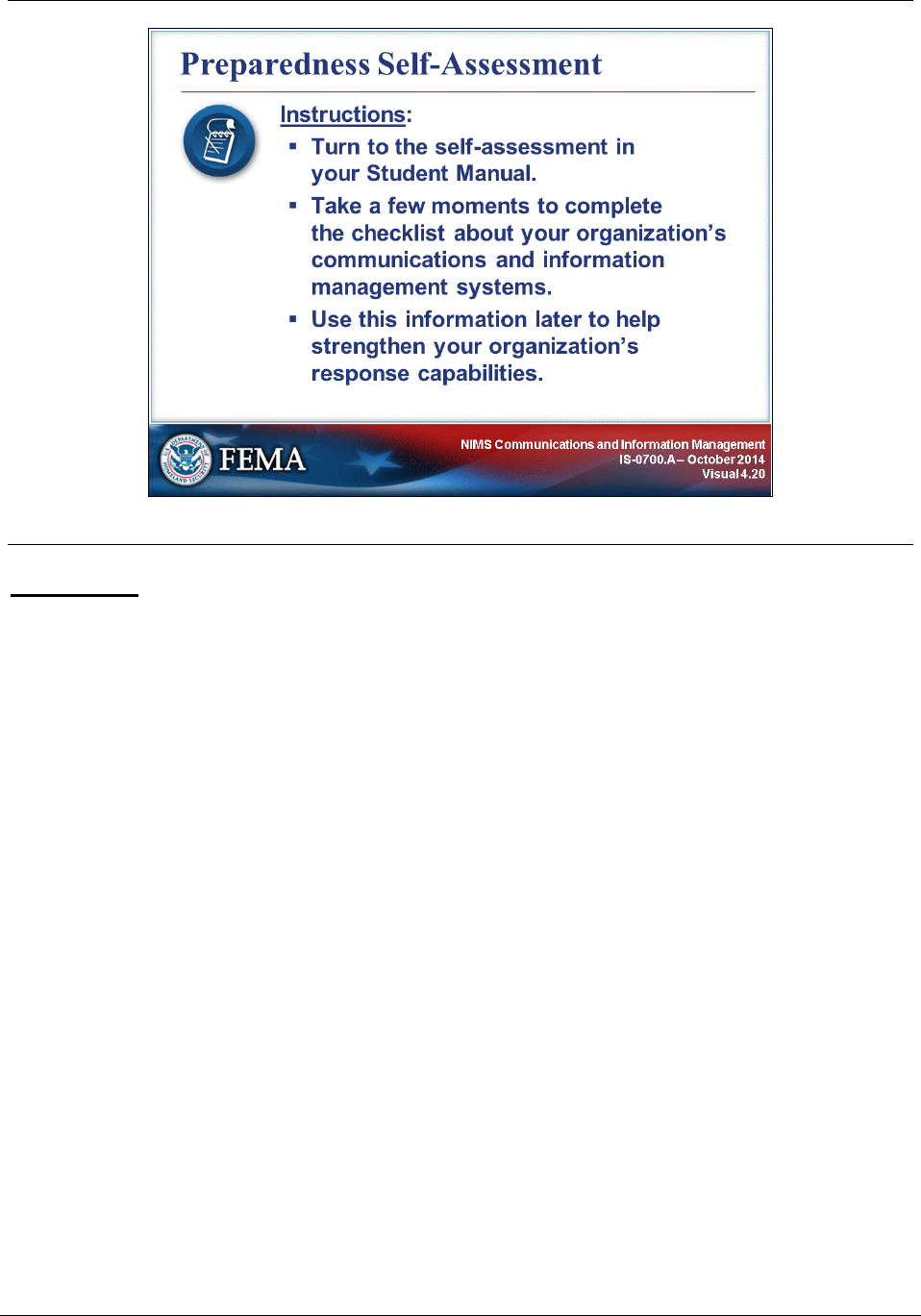
IS-0700.A: National Incident Management System, An Introduction
Key Points
Instructions:
Turn to the self-assessments in your Student Manual.
Take a few moments to complete the checklists about your organization’s communications
and information management systems.
Use this information later to help strengthen your organization’s response capabilities.
Page 4-24 Student Manual October 2014

IS-0700.A: National Incident Management System, An Introduction
Self-Assessment:
Communications and Information Management Preparedness
Purpose: A common operating picture is established and maintained by the gathering, collating,
synthesizing, and disseminating of incident information to all appropriate parties involved in an
incident.
Instructions: Complete the following self-assessment to assess your jurisdiction’s, agency’s, or
organization’s communications and information management systems preparedness. Use this
information to ensure that your jurisdiction, agency, or organization is preparing effectively.
Communications and Information Management
Systems
Yes
No
Comply with applicable national standards and are
designed to be reliable, portable, scalable, resilient, and
redundant.
Allow on-scene and off-scene personnel to have the same
information about the incident, including the availability
and location of resources and personnel, and the status of
requests for assistance.
Specify information that will flow among all stakeholders
(including the private sector, critical infrastructure owners
and operators, and nongovernmental organizations).
Set policies and procedures for coordination and release
of information to the public and media.
Designate the communications systems and platforms that
will be used (including technical parameters of all
equipment and systems).
Establish protocols for communications that require the
use of plain language (and identify exceptions when
specialized encryption and tactical language may be
used).
Identify procedures and protocols needed to ensure
operational and information security.
Specify interoperability and information-sharing
arrangements in mutual aid agreements and assistance
agreements.
Include periodic training and exercises to ensure that
personnel capabilities and limitations of communications
plans and systems are addressed before an incident.
Use the space below to make note of action items for your jurisdiction, agency, or
organization.
October 2014 Student Manual Page 4-25

IS-0700.A: National Incident Management System, An Introduction
Your Notes:
Page 4-26 Student Manual October 2014
